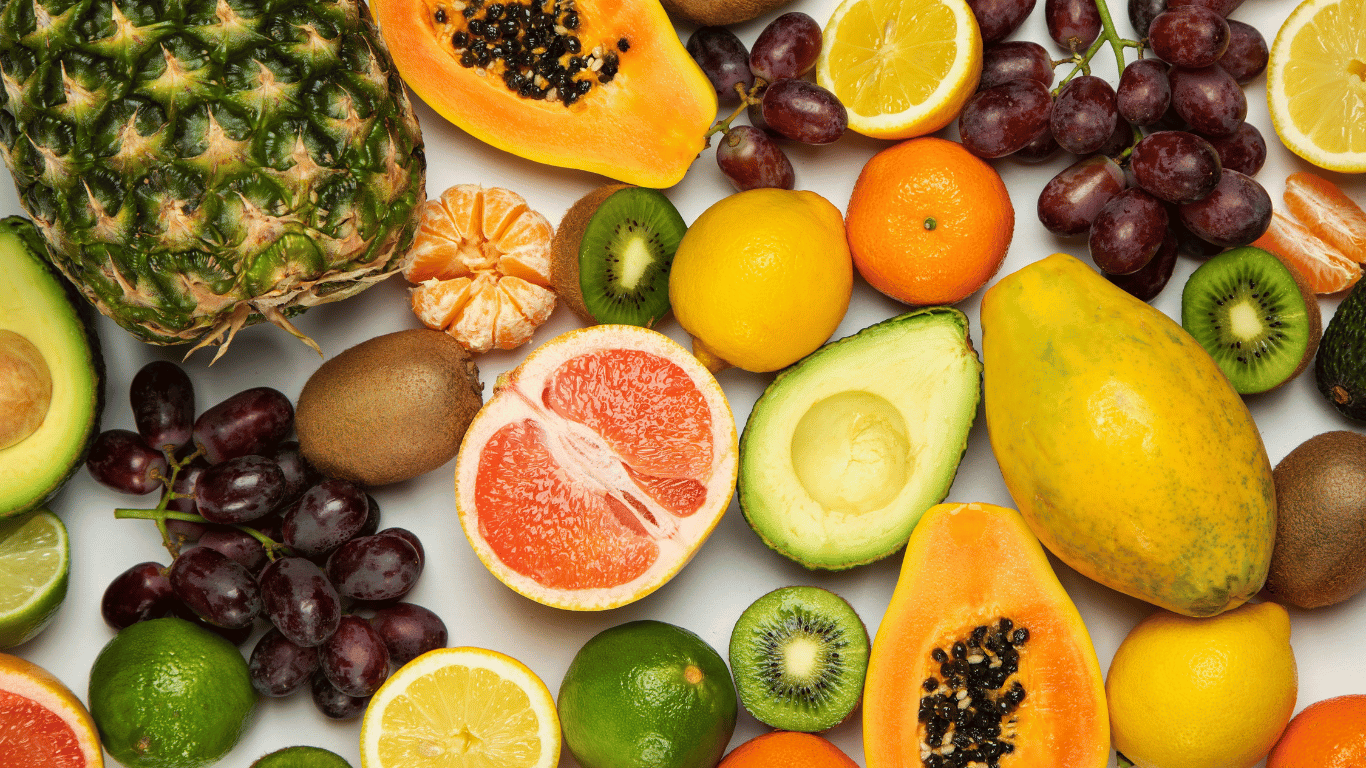
India holds the title of the world’s second-largest fruit producer, boasting a vast array of fruits cultivated across diverse geographical zones, thanks to its varied geography. With each region and culture infusing its unique flair into utilizing this abundance, a plethora of dishes emerges – from refreshing salads to delectable desserts. For an immersive experience, explore local markets during your next vacation and indulge in a bounty of flavours like no other.
1. Ambarella:
Missing out on Ambarella in India is a missed opportunity. This renowned fruit is a common delight in states like Kerala, Tamil Nadu, Goa, Maharashtra, and Karnataka, often referred to as Ambade Kaai or Ambate in local vernacular. Ambarella finds its way into various delectable Indian dishes, including juice, pickles, fruity cocktails, and fresh desserts.
With a distinctive oval shape and typically found in clusters of about 12 fruits, Ambarella exhibits a green hue and firm texture when unripe, transforming into a golden-yellow colour when ripe. Notably, it houses a fibrous pit in the center.
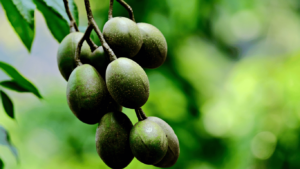
The flavour is a delightful blend of mango’s tartness and a hint of pineapple’s sweetness, complemented by a tangy undertone. The sweet variant, known as Kasi Ambate, offers an additional taste dimension. Nutritionally, Ambarella is a source of calories, protein, carbohydrates, vitamin C, vitamin A, calcium, iron, fiber, and phosphorus.
In India, the prime season for Ambarella is during the fall and winter months, presenting an ideal time to savour its unique and refreshing taste.
2. Indian Sherbet Berries/ Phalsa:
Indigenous to Varanasi, India, this tiny fruit has made its mark across the nation, with widespread cultivation. Introduced to other Asian countries and various parts of the world by Buddhist scholars, it has found a place in local markets throughout India.
Featuring a striking deep purple hue, this fruit bears a resemblance to blueberries in appearance. It stands out as an exceptional edible drupe.
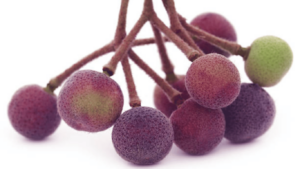
The allure of this fruit lies in its delightful combination of sweetness and tartness. Indians often pair it with sugar to create sherbet or squash, while enjoying its natural taste when consumed fresh. Additionally, it serves as an astringent, cooling, and stomachic agent. Nutritionally, this fruit provides ample calories, carbohydrates, calcium, and phosphorus.
The harvesting season varies, with people typically picking it from March to April in the South and May to June in the North, providing an opportunity to relish its unique taste.
3. Mimusops – Khirni/ Rayan:
Widely found in the Indian subcontinent, Southeast Asian countries, and China, Mimusops thrives in the Central regions and Deccan Peninsula of India. Known as Khirni in India and various South Asian regions, it has become a popular local favourite.
With an attractive golden and smooth skin, the unforgettable yellow hue of its delicious pulp stands out. Housing a large seed in the middle, its milky and sweet flavour evokes memories of the taste of Sapota.
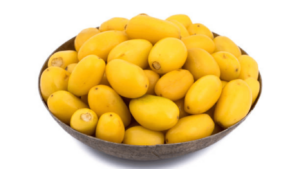
Beyond taste, this fruit boasts numerous health benefits, particularly serving as a common choice for addressing dental ailments. Nutritionally, Khirni is a rich source of proteins, carbohydrates, fats, vitamin C, vitamin A, antioxidants, tannins, and triterpenoids.
The prime season for Khirni runs from April to June, providing ample opportunities to relish this flavourful fruit.
4. Rambutan:
An emblematic fruit in Southeast Asian countries, Rambutan is notably prevalent along the western coast of Karnataka and Kerala in India. Resembling Lychee, Pulasan, and Longan in structure, Rambutan comprises three components – skin, flesh, and seed. Its name, derived from the Malay word “Rambut,” meaning “hair,” alludes to the myriad spines covering its rind.
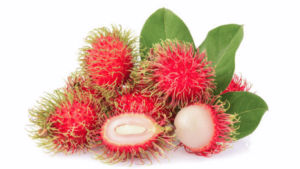
Distinguished by its round and oval shapes, Rambutan is easily identifiable by its reddish leathery skin. Upon peeling away the skin, one can relish the exquisite sweet taste and a subtle acidity from its whitish or pale pink flesh. The fruit emanates an enticing fragrance attributed to numerous volatile organic compounds.
Nutritionally, Rambutan is rich in carbohydrates, with negligible fat, calories, fatty acids, oleic, and a notable presence of vitamin C. The season for Rambutan spans from July to October.
5. Langsat- Langsah/Lotka:
Langsat is a distinctive Indian fruit that beckons exploration when visiting the eastern and southern regions. The Nilgiri hills boast the highest abundance of Langsat in India. Belonging to the Mahogany family, this fruit is native to Southeast Asia.
Presenting itself in round, elliptical, or oval forms, Langsat typically resembles a small potato with a surrounding yellow hair layer. Upon peeling its thick skin, one discovers small segments reminiscent of peeled garlic, with a white aril encapsulating a delightful blend of sweetness and acidity around flat seeds—each section containing a seed.
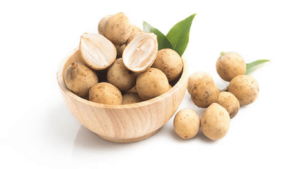
The flavour profile of Langsat evokes similarities to both grape and grapefruit, with its flesh serving as a rich source of fructose, glucose, and sucrose. A larger variant is often referred to as Duku. Nutritionally, Langsat contributes essential vitamins, including A, C, thiamine, and riboflavin.
The prime season for Langsat in India unfolds from April to September, offering a ripe and flavorful experience during this period.
6. Buddha’s Hand (Fingered Citron):
When delving into the realm of Indian fruits, one cannot overlook the unique Buddha’s Hand or Fingered Citron. Its distinctive appearance resembles that of a hand with numerous tiny fingers, presenting itself in both open-hand and closed-hand forms. The origin of Buddha’s Hand is a subject of controversy, with conflicting ideas suggesting it may have originated in the lower Himalayas region.
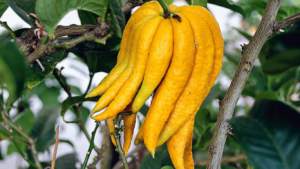
The fruit stands out with its striking yellow skin, housing an acidic pulp layer that immerses you in its characteristic flavour. Notably, its fragrance leaves a lasting impression, enhancing the overall sensory experience. Nutritionally, Buddha’s Hand is rich in calcium, dietary fiber, vitamin C, carbohydrates, proteins, fats, limonin, and diosmin. It is seedless.
This unique fruit is available from late October to January, providing a seasonal window to appreciate its distinct taste.
7. Tree Sorrel- Bilimbi:
Bilimbi, also known as Tree Sorrel, indigenous to Indonesia and Malaysia, thrives abundantly in the warm and coastal regions of India.
Characterized by its ellipsoidal and elongated form, Bilimbi boasts a smooth skin adorned with a wax layer, leaving a lasting impression. Ripe Bilimbi can be observed in hues ranging from light green to yellowish-green, offering a delightful contrast to its crispy, succulent, and acidic flesh.
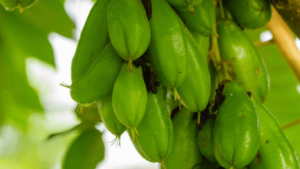
Given its pronounced acidity, Bilimbi is not commonly consumed fresh; instead, it finds its way into lemonade-type drinks, pickles, chutneys, or jams. However, if you’re inclined to savour raw Bilimbi with a hint of spice and salt, a culinary adventure to Maharashtra and Goa awaits. Nutritionally, Bilimbi emerges as a rich source of vitamin C, B, calcium, flavonoids, tannins, iron, and terpenes.
It is available throughout the year, ensuring a continuous opportunity to relish its distinct taste.
8. Starfruit – Carambola:
Starfruit thrives abundantly in the southern regions of India. Native to Southeast Asia, it found its way to the Indian subcontinent through Austronesian traders, along with Langsat, Coconut, and Santol.
In contemporary times, Carambola cultivation has expanded to include China, Taiwan, America, Hawaii, Africa, and the Caribbean. This versatile fruit is utilized entirely in cuisine, showcasing a dominant yellow and green skin with an eye-catching thin wax layer. Notably, its unique structure, with edges resembling stars when cut horizontally, adds to its visual appeal.
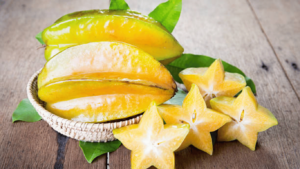
Most Starfruits boast a sour flavour with a hint of sweetness, and ripe sweet varieties contain about 4% sugar. When enjoying Starfruit, the taste conjures a delightful blend reminiscent of apple, grape, pear, and citrus fruits.
In Indian cuisine, Starfruit is often combined with vegetables or transformed into jams. Unripe Starfruit makes a delectable addition to mouth-watering Indian salads, and refreshing drinks featuring Starfruit are also relished. Nutritionally, Starfruit serves as a source of fiber, vitamin C, B, folate, copper, magnesium, and potassium.
The peak season for Starfruit spans from September to October and January to February, offering optimal periods to indulge in its unique taste.
9. Camachile- Jungli Jalebi:
Camachile, or Manila Tamarind, is a fruit widely distributed in various regions of India, including Maharashtra, Kerala, Tamil Nadu, West Bengal, and Karnataka. Originally hailing from the Pacific Coast, Mexico, South America, and Central America, this fruit has found common cultivation in Southeast Asia, South Asia, the Caribbean, and various other parts of the world. In India, it is colloquially referred to as Jungli Jalebi, drawing parallels with the appearance of the Indian sweet Jalebi.
The Camachile is a pod formed from the flowers of the tree, showcasing a characteristic pink colour when ripe. Beneath the skin lies a pink or white pulp layer, accompanied by about 5 to 6 black seeds in each Camachile.
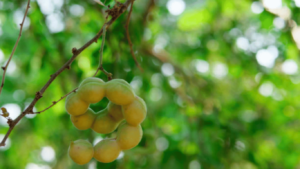
The versatile nature of Camachile allows for the utilization of both its pulp and seeds, making it a popular ingredient in various sweet treats in India. Its delightful sweet-tangy flavour is well-suited for culinary applications, adding a tangy twist to curries. Additionally, Camachile is recognized for its medicinal uses. Nutritionally, Camachile is rich in vitamin C, B, potassium, and sodium.
The season for Camachile spans from February to March or May, providing a window to appreciate its unique taste.
10. Mangosteen – Mangustaan:
The Mangosteen, originating in the tropical regions surrounding the Indian Ocean, is notably cultivated in Southeast Asia, Colombia, and Puerto Rico.
The cultivation of Mangosteen has flourished in the Nilgiri hills and Southern India. It gained recognition for its appearance in numerous Thai dishes, so much so that it is often considered the national fruit of Thailand. Historical records suggest its introduction to India in the 18th century.
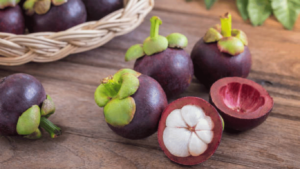
Distinguished by its dark purple skin (which turns green when unripe), Mangosteen unveils about 4 to 8 opaque segments of sweetness and sourness once its thick rind is removed, inviting a sensory experience that captivates with its juiciness. Nutritionally, Mangosteen offers a spectrum of nutrients, including carbs, calories, vitamin C, B, calcium, magnesium, and phosphorus.
The prime season for Mangosteen in India unfolds from July to October and again from April to June, providing ample opportunities to savour its distinctive taste.
©Famous India Blog. All rights reserved.
Creativity By Needinfotech